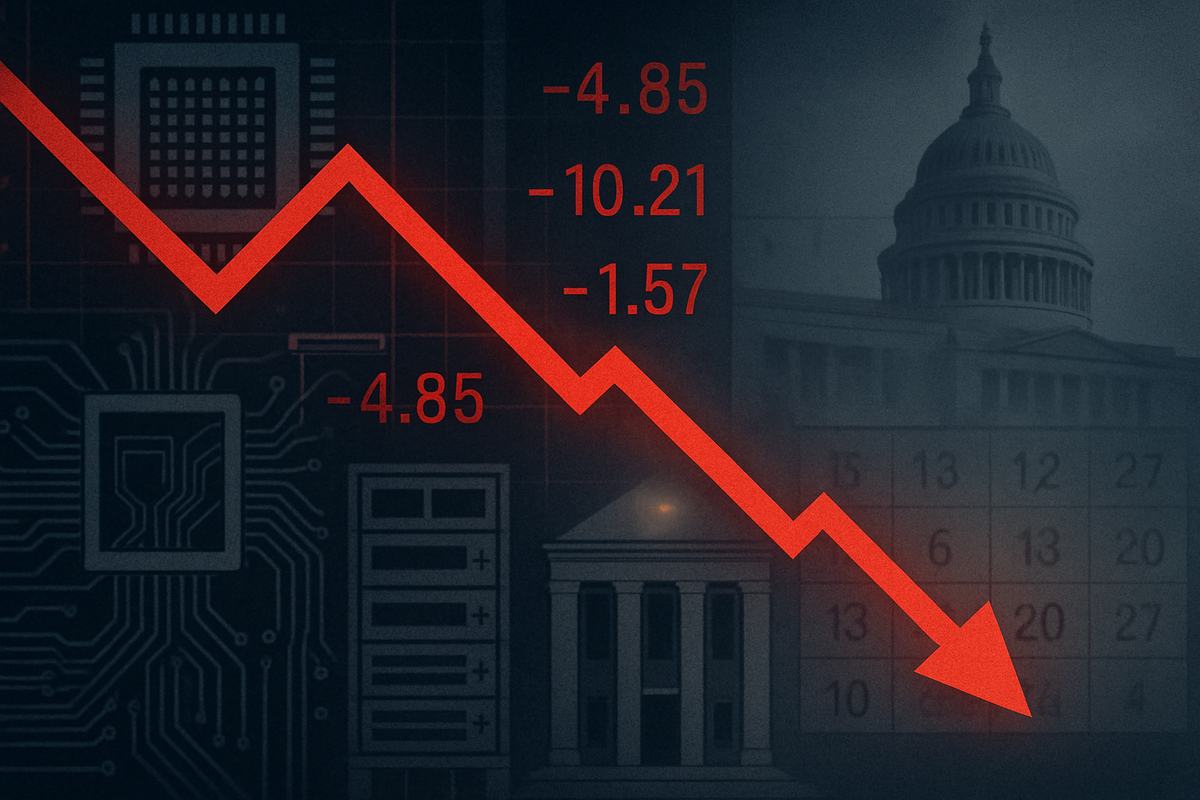
The Nasdaq 100, a key barometer for the US technology sector, is currently experiencing significant valuation pressures and a notable retreat from its recent highs. This market shift, observed around early October 2025, is primarily driven by a complex interplay of factors: the subtle cooling of aggressive Federal Reserve (Fed) rate cut expectations, mounting concerns over stretched valuations in the tech sector, and the ongoing US government shutdown. After a robust rally that propelled major indices to unprecedented levels, this pullback signals a period of reassessment for investors, particularly those heavily invested in growth-oriented tech stocks.
This environment has led to increased market volatility and a re-evaluation of equity risks, especially for rate-sensitive sectors and companies with high valuations. The confluence of these macroeconomic and political headwinds is fostering a more cautious sentiment across the financial markets, challenging the optimistic outlook that has largely defined the tech sector's performance in previous months.
Detailed Coverage: Unpacking the Tech Sector's Retreat
Leading up to the current period in early October 2025, the Nasdaq 100, S&P 500, and Nasdaq Composite indices surged to unprecedented levels, propelled by strong optimism for Federal Reserve interest rate cuts and sustained enthusiasm for artificial intelligence (AI) advancements. On October 8th and 9th, 2025, these indices reached new all-time highs, with market participants pricing in a high probability (around 95%) of an October rate cut and expectations for potentially two more cuts by year-end, based on September's Federal Open Market Committee (FOMC) minutes.
However, immediately following this peak, a significant shift occurred. As of October 7th and 9th, US stocks began to retreat, with the Nasdaq 100, S&P 500, and Dow Jones all posting losses, reversing the momentum from their recent AI-driven rallies. This pullback is attributed to several critical factors. Firstly, while the Fed minutes still indicated a dovish bias, they also revealed policymakers' caution regarding inflation, tempering expectations for swift and aggressive easing. New York Fed President John Williams, for instance, voiced support for "lower rates this year" only if inflation rises to around 3% and unemployment increases beyond 4.3%, acknowledging downside risks to the labor market.
Secondly, the multi-week rally had pushed indexes into "overbought" territory, raising concerns about stretched valuations, particularly within the tech sector. This environment spurred profit-taking, causing a retreat in high-growth names. Lastly, an ongoing US government shutdown, entering its second week as of October 9, 2025, introduced significant uncertainty. It delayed the release of crucial economic data, such as the September jobs report and weekly unemployment claims, hindering market insight into the economy and complicating the Federal Reserve's decision-making process. This data vacuum has contributed to heightened uncertainty and a more cautious market sentiment.
Company Crossroads: Winners and Losers in a Shifting Landscape
The current market environment, characterized by fading rate cut hopes, valuation pressures, and a government shutdown, creates a distinct set of winners and losers within the Nasdaq 100. Companies with robust fundamentals, strong cash flows, and less reliance on debt are better positioned to weather the storm, while highly valued growth stocks, particularly those dependent on future earnings, face significant headwinds.
Companies Facing Challenges: Highly valued growth stocks, especially in the AI sector if expectations are not met, are vulnerable. The Bank of England has warned that equity market valuations, particularly for AI-focused technology companies like Nvidia (NASDAQ: NVDA), AMD (NASDAQ: AMD), and Oracle (NYSE: ORCL), appear "stretched." A prolonged period of higher interest rates could exacerbate this by increasing the discount rate for future earnings, making current valuations less attractive. Tesla (NASDAQ: TSLA), a significant Nasdaq 100 component and a rate-sensitive consumer discretionary stock, could see further dampened consumer demand for big-ticket items like electric vehicles due to higher interest rates. Generally, any Nasdaq 100 company with a high price-to-earnings (P/E) ratio and a valuation driven primarily by future growth rather than current profitability is exposed. Companies with significant debt will also face headwinds as borrowing costs rise. Furthermore, companies reliant on government contracts or regulatory approvals, such as Palantir Technologies (NYSE: PLTR) for its government segment, could experience payment delays or hindered approvals due to a prolonged government shutdown.
Companies Showing Resilience or Potential Opportunity: Despite valuation concerns, leading AI infrastructure providers and tech giants continue to be primary drivers. Nvidia (NASDAQ: NVDA), Advanced Micro Devices (NASDAQ: AMD), Microsoft (NASDAQ: MSFT), Apple (NASDAQ: AAPL), Alphabet (NASDAQ: GOOGL), Amazon (NASDAQ: AMZN), and Meta Platforms (NASDAQ: META), often referred to as the "Magnificent Seven," alongside other AI-related companies like Dell Technologies (NYSE: DELL), Super Micro Computer (NASDAQ: SMCI), and Marvell Technology (NASDAQ: MRVL), are benefiting from robust demand for AI chips, cloud computing, and software solutions. Their strong demand and innovation act as powerful tailwinds. The market is currently prioritizing "fundamental economic drivers and technological advancements over short-term political discord." Companies with strong cash flow and less reliance on debt, such as IQSTEL Inc. (NASDAQ: IQST), are better positioned to navigate a "higher for longer" interest rate environment. Businesses with diverse revenue streams and less direct reliance on US government spending or domestic consumer sentiment are also likely to be more resilient.
Wider Significance: Ripple Effects and Historical Echoes
A retreat in the Nasdaq 100, heavily weighted towards technology stocks, signals a broader market shift away from growth-oriented assets. Fading hopes for Fed rate cuts mean that the cost of borrowing remains higher, directly impacting tech companies that often rely on readily available and cheaper capital for expansion and innovation. High-valuation tech stocks are particularly sensitive to interest rate trajectories, as higher rates reduce the present value of future earnings, making these stocks less attractive. Investors may rotate capital from growth-oriented tech stocks into more defensive or value-centric sectors, such as energy, healthcare, and consumer staples, which tend to be more resilient during periods of uncertainty and higher rates.
This event fits into broader industry trends characterized by an unprecedented concentration of market capitalization in a few mega-cap technology companies. While these companies have driven significant market gains, their outsized influence means a correction can have ripple effects across the entire market. Concerns over the true return on massive AI investments and the sustainability of the AI-driven market boom have begun to emerge, leading to a re-evaluation of the sector's robust performance. A downturn in US tech stocks could have significant ripple effects throughout the tech ecosystem, impacting smaller competitors, partners, and global markets.
Regulatory scrutiny and policy implications are also significant. A prolonged tech sector correction could intensify calls for regulation, as concerns about market stability or potential speculative bubbles gain traction. Governments worldwide have been increasingly scrutinizing the power and influence of large tech companies, particularly concerning data privacy, antitrust, and the ethical implications of AI. Furthermore, the government shutdown delays crucial economic data, complicating the Federal Reserve's ability to make informed monetary policy decisions.
Historically, the current market concentration and high valuations in the tech sector, especially driven by AI enthusiasm, draw comparisons to the dot-com bubble of 2000-2002. During that crash, the Nasdaq Composite Index fell nearly 78%, and many unprofitable startups failed. While today's leading tech giants are generally profitable, the speculative nature of some AI investments echoes that era. US government shutdowns, while typically having muted and temporary effects on financial markets, can exacerbate uncertainty, especially when combined with monetary policy shifts.
The Road Ahead: Navigating Uncertainty and Opportunity
The future outlook for the Nasdaq 100 and US tech stocks is a blend of challenges and opportunities, shaped by monetary policy, political stability, and the relentless pace of technological innovation. In the short term, the duration and economic impact of the US government shutdown will be critical. While historical precedents suggest markets often look past temporary political disruptions, a prolonged impasse could lead to accumulating economic risks and further dampen sentiment.
The Federal Reserve's stance on interest rates remains a central determinant. While rate cuts are anticipated later in 2025, the pace and magnitude will be influenced by inflation trends and economic data. Historically, the period immediately following the commencement of rate cuts can see market declines as the Fed often cuts rates to counter an economic slowdown. This could lead to further pressure on overvalued stocks. Concerns about an "AI bubble" are also growing, suggesting that a period of consolidation or a healthy pullback would not be surprising if AI adoption or revenue generation falls short of lofty projections.
Long-term, however, the underlying drivers of digital transformation, AI innovation, and cloud computing are expected to continue shaping the tech landscape. Global IT spending is projected for significant growth, with data center and software segments experiencing double-digit expansion. The focus will shift from AI experimentation to proving its business value by driving measurable return on investment. This environment will necessitate strategic pivots for tech companies, prioritizing efficiency, profitability, and prudent capital allocation. Companies must lead by example in adopting AI-first systems internally and exploring new revenue streams.
For investors, opportunities may emerge in resilient companies with strong fundamentals, particularly those genuinely leveraging AI for transformation and growth. A market correction could also create buying opportunities in undervalued sectors. Challenges include persistent valuation concerns, interest rate sensitivity, potential economic slowdowns, increased regulatory scrutiny, and geopolitical tensions. Companies will need to diversify supply chains and operations to build resilience against these headwinds.
Market Minute Wrap-Up: A New Chapter for Tech Investors
The current retreat in the Nasdaq 100 and the broader US tech sector in October 2025 marks a significant recalibration for the financial markets. Key takeaways include the market's heightened sensitivity to Federal Reserve policy shifts, the growing scrutiny of tech valuations—especially in the AI space—and the disruptive, albeit often temporary, impact of political gridlock like the ongoing government shutdown. This period underscores a transition from an era of readily available cheap capital to one where profitability, cash flow, and financial resilience are increasingly paramount.
Moving forward, the market's trajectory will hinge on the resolution of the government shutdown and the Federal Reserve's subsequent policy decisions. Investors should closely monitor Fed communications, particularly for any hawkish commentary, and track the eventual release of delayed economic data. Corporate earnings reports from major technology companies will provide critical insights into their ability to navigate macroeconomic headwinds, with a focus on revenue growth, profit margins, and forward guidance. Any geopolitical developments will also remain a significant factor influencing market sentiment.
The lasting impact of this period could be a more discerning market, less inclined to reward "growth at any cost" and more focused on sustainable business models. While the long-term potential of AI and technological innovation remains robust, investors are likely to become more selective, favoring companies with strong balance sheets and clear paths to generating shareholder value. This environment calls for a diversified, long-term investment strategy, emphasizing companies with robust fundamentals that can withstand various economic cycles. The coming months will be crucial in determining whether this retreat is a healthy correction or the precursor to a more significant market shift.
This content is intended for informational purposes only and is not financial advice.







